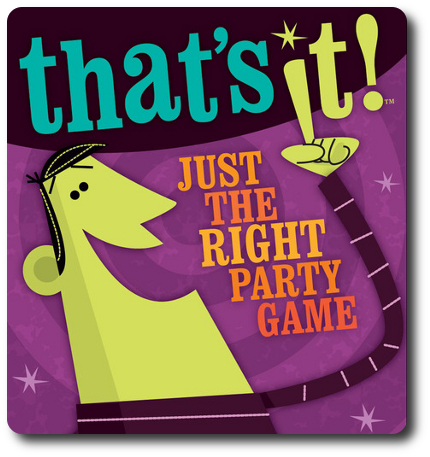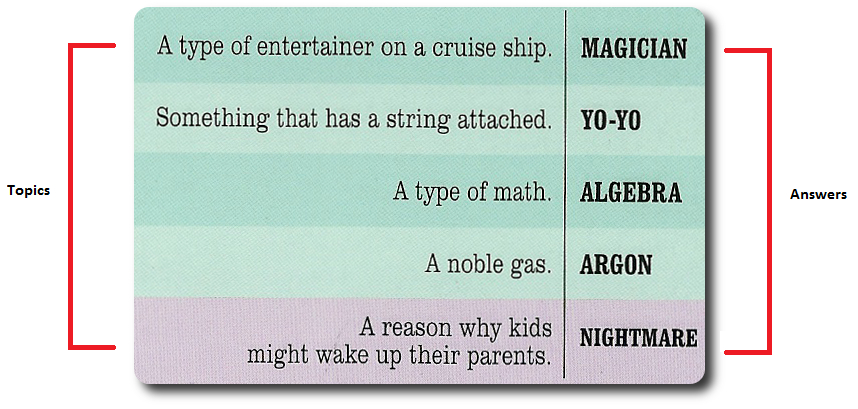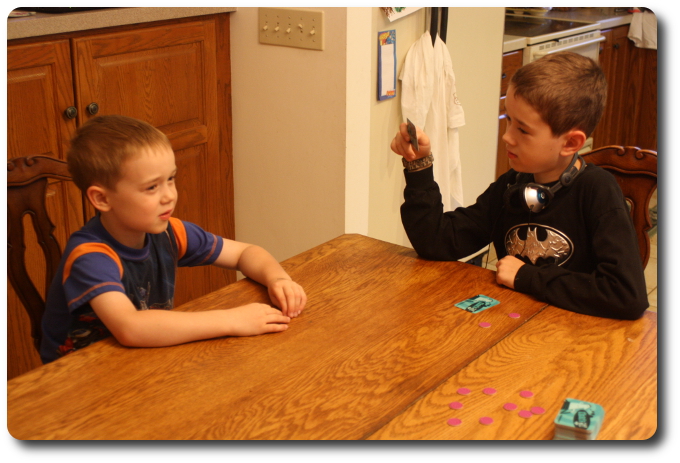
The Basics:
- For ages 6 and up (publisher suggests 10+)
- For 3 or more players
- Variable game play length
Geek Skills:
- Active Listening & Communication
- Counting & Math
- Logical & Critical Decision Making
- Reading
- Reflex & Speed
Learning Curve:
- Child – Easy
- Adult – Easy
Theme & Narrative:
- None
Endorsements:
- Gamer Geek rejected!
- Parent Geek approved!
- Child Geek mixed!
Overview
Sometimes, there are multiple answers to a single question. For example, if I were to ask you what tool is found in a tool box, the number of correct answers is more than I care to count. But what if I were to tell you that I’m only looking for one specific tool that answers the question? Well, now, that’s a bit different, isn’t it? In this game of logical deduction and quick wit, players will be asked a question that has many correct answers but only one that is right!
That’s It!, designed by Roland L. Tesh, Garrett J. Donner, Michael S. Steer, and published by Gamewright, is comprised of 200 Topic cards and 12 Scoring tokens. The Topic cards are durable and the Score tokens are made of thick cardboard. The game presentation is very minimalistic. The entire game fits in a small box, which makes it portable and easy to store.
Game Set Up
To set up the game, first shuffle the 200 Topic cards and place them face-down in the middle of the playing area. This is the Topic draw deck.
Second, place the 12 Scoring tokens, number side down, in the middle of the playing area and randomize them by shifting their position around until they are thoroughly mixed.
And that’s it for That’s It! Determine who will be the first player and begin!
A Rose By Any Other Name Is Incorrect
That’s It! is played in rounds. Each round consists of 5 topics. All players participate at once, but there are two primary roles. The first is the Topic Reader. This individual is the person who reads the Topic cards. All the other players are the Guessers who will be shouting out their guesses to specific topics read by the Topic Reader.
A typical round is as follows:
Step 1: Draw a Topic Card
The Topic Reader for the round draws the top most Topic card from the Topic draw deck and reads the five topics and their answers to themselves. The Topic Reader should not show the card to any of the other players (the Guessers).
Step 2: Read the Topics
One topic at a time, and starting at the top most topic, the Topic Reader reads aloud the sentence that describes the topic answer. Example of a Topic card follows.

Step 3: ANSWER!
All the Guessers now attempt to guess what the topic being discussed or described is. Guessers shout their answers all at once, meaning the Topic Reader will have to listen closely.
Step 4: Correct or Really, Really Wrong
There is only 1 correct answer for every topic and the Guessers have about 30 seconds to guess it. If they fail to do so or the Guessers stop guessing before 30 seconds has lapsed, the Topic Reader randomly selects one of the Score tokens and reads the topic answer to the Guessers. The Score token value is note shared. The next topic is now read on the card.
If a Guesser does guess the word, the Topic Reader shouts, “THAT’S IT!”, or something like that and the Guesser randomly selects one Score token. Again, the value of the Score token is not shared. The next topic is now read on the card. If two or more Guessers shout the correct answer at the same time, a Scoring token is selected by each correct Guesser.
Note that Guessers are not penalized for guessing incorrectly. Guessers can attempt to guess what the topic is as many times as they like. Topic Readers should not provide any helpful hints or suggestions since it’s in their best interest to not have the correct answer guessed.
Step 5: Final Topic and Scoring
The fifth and final topic is a “Bonus Topic”, but it’s played out exactly like the previous 4 topics that came before it. The “Bonus Topic” is worth 2 Score tokens.
Once the fifth and final topic answer is revealed, all the players, including the Topic Reader, now reveal their Score tokens and add up the numbers shown. The player with the most total points is awarded the Topic card. If there is a tie, all the players with the highest tied score are awarded a Topic card.
Step 6: Continue!
The game now continues! All the Scoring tokens are placed back in the middle of the playing area, face-down, and randomized as before. The player to the Topic Reader’s left is the new Topic Reader. A new rounds now begins with Step 1 noted above.
Finish It!
The game ends as soon as any player earns their 3rd Topic card and wins the game. If there is tie with 2 or more players earning their 3rd Topic card at the same time, randomize the Scoring tokens, face-down, and have each player who was involved in the tie draw a single token. The player with the highest Score token value wins the game.
Game Variant
For a longer game, simply increase the number of Topic cards that must be earned in order to win.
To learn more about That’s It!, visit the game’s web page.
Prediction
That’s It! is going to appeal most to our non-gamers and very casual game players. The game itself is easy to grasp and meant to be played in a very non-gaming way. Which is to say, loudly and chaotically. That is exactly why I don’t think our Gamer Geeks are going to approve of this party game. Despite it being designed for a party atmosphere (which is already loud and can be chaotic), the lack of any real meaningful game play and tactics (other than simply being smarter and louder than your opponents) is going to cause this party game to be a big downer for our gaming elitists.
For our Child Geeks, their level of acceptance is going to be based on two important points. First, the Child Geeks must feel like they are able to participate on a meaningful level. Second, the game must be winnable, meaning the Child Geeks are not being steamrolled over by their older peers and the Parent Geeks. And while reading is part of the game play, it’s only necessary if the player is the Topic Reader. Players can participate and win the game without ever being the Topic Reader. This will allow younger Child Geeks to participate without issue.
The Parent Geeks are going to enjoy this game. It’s fast, sociable, and very casual. The easy game play will appeal to all our Parent Geeks, with the only exception being those Parent Geeks who don’t like noisy games. But, let’s be honest. Any Parent Geek who doesn’t like noise made a serious miscalculation when they had kids.
Teaching the game is very simple. All you have to tell your players is, “I’m going to speak a sentence that describes a topic and then you need to shout out what you think the answer to the topic is before your opponents do.” And that’s it. It will be helpful to give a few examples, but not necessary.
And so, after teaching That’s It! to my family, I asked them their thoughts on the game so far.
“Sounds like fun!” ~ Liam (age 9)
“I’m not going to know all the answers, but I’ll try my best.”~ Nyhus (age 6)
“Oh, yeah! Let’s play this game, Daddy!” ~ Ronan (age 3)
“Wait. So everyone is going to be shouting? I feel a headache coming on.” ~ Wife
Yes, the game will be loud, but only as loud as the number of people who are playing it. The smallest number you can play with is 3 but you could technically play with as many as 30 or more. Now that would be a loud game. Let’s play That’s It! and see if the game is really all it says it is and hopes to be.
Final Word
The Child Geeks were mixed when it came to liking or disliking That’s It! For the older Child Geeks (ages 6 and up), That’s It! was a game well within their grasp and they did fairly well. Their individual level of success at the game was primarily based around age and education. When playing with their peers, the Child Geeks did very well, but when put in a group with much older players, they never stood a chance. This frustrated some of the Child Geeks and barely registered with others. In the end, the game was a mixed bag of likes and dislikes based on the individual player’s perception of how “fair” the game was. According to one Child Geek who loved the game, “I loved shouting out the answers, even if I wasn’t right!” And according to another Child Geek who didn’t like the game, “I hated it because I didn’t know anything!” While the game was found to be playable with younger Child Geeks (my 3-year-old even played), the suggested minimum age for the game most likely captures the basic level of life experience and education a player needs in order to be competitive. Individual results will vary widely, of course.

My 6-year-old pauses a moment to think of his next guess while the rest of the table shouts answers
The Parent Geeks, especially the non-gamer Parent Geeks, really enjoyed the game and thought it was a lot of fun. The game comes with 200 Topic cards which makes it exceedingly unlikely that a player would remember the individual cards even after several gaming sessions. The game is just too fast to allow players the chance to store any answers in long-term memory. The Parent Geeks were not big fans of the Score tokens, however. A player who wins 2 Score tokens could technically score more points than a person who scored 4. Regardless, all the Parent Geeks voted to approve the game with the biggest thumbs-up coming from the non-gamer Parent Geeks.
The Gamer Geeks, who are notoriously picky about their party games, did not approve That’s It! They found the game to be nothing more than a shouting match and had little redeeming value. According to one Gamer Geek, “This game is nothing more than shouting random answers, and the fact that there is ever only 1 correct answer is somewhat frustrating.” Indeed, the answers to the cards sparked a number of debates that focused on how wrong the cards were or why the provided answer was even a good one to being with. The game frustrated more than amused the Gamer Geeks. This was especially true when they played the game with non-gamers. Gamer Geeks are competitive by default and they rather disliked that they couldn’t obtain a distinct advantage or edge. One Gamer Geek said, “This isn’t a game I would want to party down with.” I thought that was rather witty.
I continue to believe that Party Games are the most complicated game to design. Most game designers can target their audience and design the game around the group and their supposed skill level. You can’t do that with Party Games. That’s It! played well with many of our players, but bombed with just about the same number. This proved to me, once again, that a Party Game is only as much fun as the audience who wants to have fun with it. Of course, this can be said for just about every game on the market, but it remains the single most determining factor regarding a game’s endorsement when it comes to a Party Game. If the group isn’t in the party mood, the game will fall flat on its face. If they are, the game will be herald as the life of the party.
That’s It! is as much about listening as it’s about tuning out the other players. A player will greatly benefit from listening to other guesses and taking into account what has been said and not said. Of course, a player will also highly benefit from simply not listening to other players shout out random answers. Since the Topic Reader will not provide any suggestions concerning how close or accurate the Guessers are, players will either eventually guess correctly or stop guessing. Either way, the game will continue in 30 seconds.
That’s It! is going to be a Party Game that will be well received by party goers who like visiting and debating in a very chaotic way. It’ll also be a great ice-breaker game and for party groups who don’t have much in common other than possibly being at the same party. Give it a try and see if That’s It! really is the right party game for you, as the game box suggests. If not, there is always 20 Questions.
This game was given to Father Geek as a review copy. Father Geek was not paid, bribed, wined, dined, or threatened in vain hopes of influencing this review. Such is the statuesque and legendary integrity of Father Geek.



